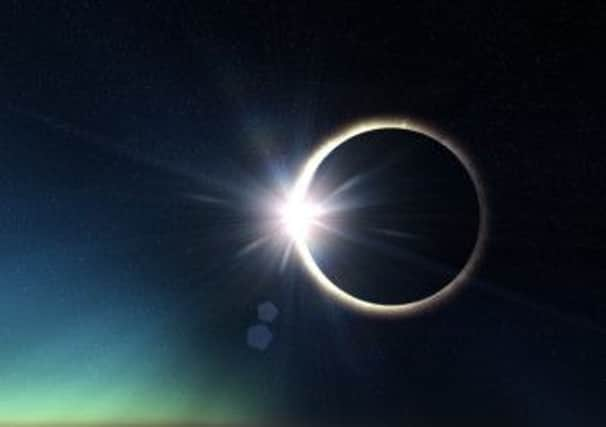Your chance to see solar eclipse - and how to do it safely


From our spot on the globe we will see a 95 per cent eclipse while viewers in the far west of Ireland and most northern parts of Scotland will witness a 98 per cent eclipse, Arctic regions and the Faroe Islands will see a total eclipse.
For this area the eclipse will reach its maximum at 9.30am, the entire celestial event will last around two hours.
Advertisement
Advertisement
Please remember that you must never look directly at the sun, even with sunglasses
An eclipse happens when the Moon in its orbit of the Earth passes between us and the Sun. A total eclipse happens when the celestial dance lines up just right and the Moon’s disk exactly covers that of the Sun - coincidentally the Moon and Sun appear to be exactly the same size in our skies (the Sun very large and far away while the Moon is miniscule on the cosmic scale and at 238,855 miles away practically on top of us in the cosmos).
There will also be a Supermoon the evening before the eclipse, meaning the Earth and Moon are as close together as they can be. This makes this 2015 Spring Equinox eclipse a supermoon eclipse, meaning a supermoon, equinox and eclipse will all fall on the same day.
One of the easiest and safest ways to view the Sun – eclipsed and uneclipsed – is to project its image on a screen using a pinhole camera or a pinhole projector.
You can make one at home using common household items.
Advertisement
Advertisement
You will need two sheets of plain white paper - printer paper is ideal or, two pieces of stiff white paper or white cardboard and for the pinhole, a thumbtack or a sharp pin.
To make a quick version of the pinhole projector, take a sheet of paper and make a very small hole in the middle of it using a pin or a thumbtack. Make sure that the hole is round and smooth.
Hold this piece of paper in front of the Sun and do not look at the Sun directly.
The second sheet of paper will act as a screen. Hold it at a distance so that an inverted image of the Sun is projected on it through the pinhole.
Advertisement
Advertisement
To make the image of the Sun larger, move the screen away from the pinholed sheet.
Do not look at the Sun through the pinhole or through the paper. When using this kind of projector, your back must be towards the Sun.
You can also see the eclipse though a box pinhole projector.
This device works on the same principle as the basic one, except it is much sturdier, easier to set on a surface and requires a few extra items to construct.
You will need:
Advertisement
Advertisement
A long cardboard box or tube. Any shipping box will do. If you don’t have a long box, you can tape two together to make one long box. The length of the box will determine the image size - the longer the box, the larger the image. Also required, Scissors, Duct tape, aluminium foil, pin/thumbtack, sharp knife or cutter (kids best have an adult at hand) and last but not least, a sheet of white paper.
Cut a rectangular hole on one end of the box using the sharp knife.
Using the scissors, cut an equally-sized rectangular piece of the aluminium foil. Make sure it is not crinkled.
Tape the foil over the rectangular hole you just made in the box.
Use the pin to poke a hole in the centre of the foil.
Advertisement
Advertisement
Place or tape the sheet of paper at the other end of the box.
Stand with your back towards the Sun. Place the box on your head with the hole towards the Sun. Adjust your position without looking at the Sun directly or through the pinhole until you see the Sun’s image on the paper.
Using a tube? If you are using a tube or taping two tubes together, cut the end of the tubes and tape the foil with a pinhole on one end. On the other end, tape a piece of white paper that has been cut to the shape and size of the end of the tube. This will act as the screen. Close to this end, cut a rectangular hole using the sharp knife. This will be your viewing window. With your back to the Sun, point the end with the aluminium foil towards the Sun. Look through the viewing window and you will see the eclipse on the screen.
Now, a few important things to remember.
Never look at the Sun directly without protective eye gear. Even sunglasses cannot protect your eyes from the damage the Sun’s rays can do to them.
Advertisement
Advertisement
Do not look at the Sun through the pinhole. Always keep your back towards the Sun while looking at a pinhole or a binocular projection.
Most importantly of all if you do happen to make a pin hole projector, take a picture and send it to us: [email protected]